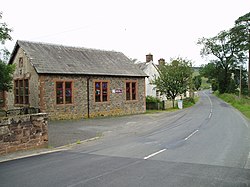Eskdalemuir Kirk
| Eskdalemuir | |
|---|---|
 The former primary school, now "The Hub". |
|
| Eskdalemuir shown within Dumfries and Galloway | |
| Population | 265 (2001) |
| Civil parish |
|
| Council area | |
| Lieutenancy area | |
| Country | Scotland |
| Sovereign state | United Kingdom |
| Post town | Langholm |
| Postcode district | DG13 |
| Dialling code | 013873 |
| Police | Scottish |
| Fire | Scottish |
| Ambulance | Scottish |
| EU Parliament | Scotland |
| UK Parliament | |
| Scottish Parliament | |
Eskdalemuir is a civil parish and small village in Dumfries and Galloway, Scotland, with a population of 265. It is sited around 10 miles north-west of Langholm and 10 miles north-east of Lockerbie.
The area consists of high wet moorlands chiefly used for sheep grazing and forestry plantation. The main settlement is located near to the White Esk river.
Eskdalemuir is probably best known for the Eskdalemuir Observatory and for the Samye Ling Tibetan Buddhist monastery.
In 2006 the Upper Eskdale Development Group was formed with the aim to reconnect the local community, after the local pub, school, and post office closed, by the development of a Community Hub based in the former school building. They have now transformed the old school into a multi-purpose community building where social activities and community support are delivered. The building houses a shop and café. UEDG members are committed to helping the isolated community at Eskdalemuir become more self-reliant and to reverse the decline that has led to the closure of local services. This in turn is expected to make the area more attractive to investors and families.
The UEDG vision is to create a dynamic hub of activity, where community support, social enterprise, businesses and training can be delivered, and cultural activities can flourish, in a place that will inspire residents and visitors alike.
The UEDG mission is to facilitate the development of a community-led regeneration of rural life by increasing access to regular, high quality services and social activities, as well as opportunities for learning through participation in cultural events and community education. UEDG would like to see services becoming increasingly localised, provided where possible by the community through social enterprise.
It is consider that this is particularly important in the context of the ageing population. As people get older and the cost of available travel increases, living in our remote rural communities can mean missing out on things others take for granted.
...
Wikipedia

